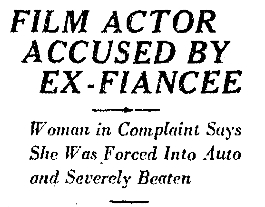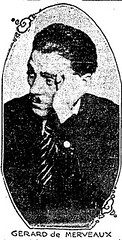May 31, 1927
Venice
If you needed proof of how the world has changed in 80 years, you need look no further than the news stories surrounding the police search for and arrest of Joe Hordeman, "elderly" war veteran and pipe murder suspect, and of Hordeman’s "December" romance with divorcee Victoria Woods, who he met at an "old folks dance" at the Sawtelle veteran’s home in late 1925.
Hordeman was enamored of Mrs. Woods and hoped to marry or go into business with her, but she found other men more fascinating. She enjoyed dancing, something Hordeman was not inclined to do with her, despite their initial meeting place. Recently she had befriended Emma O’Bell, who became her roommate and encouraged her friend’s active romantic life.
Hordeman couldn’t stand it. He bought a lead pipe and went to Mrs. Woods’ home at 109 Brooks Avenue when he thought two of her suitors would be in attendance. But he found only Mrs. Woods and Mrs. O’Bell, sitting on the porch. Incensed, he asked Mrs. Woods to go inside where they could discuss his concerns, and a raving argument erupted. Hordeman pulled out his pipe and beat her unconscious, then took a knife and neatly cut her Achilles tendons to ensure she would never dance again. He needn’t have bothered save for the symbolism; she died of her injuries. Mrs. O’Bell saw the attack through the window and rushed inside, and was herself badly beaten. Saved from injury was Mrs. Woods’ daughter, who had gone to Chicago the morning of the slaying to speak with her father about her parents reuniting.
The whole horrible affair was witnessed by 15-year-old neighbor Catherine Franklin through her kitchen window, but the dishwashing girl was so traumatized that she did not immediately cry out, and the killer walked down the alley and escaped. He turned himself in the next day after registering at a Los Angeles hotel and mistakenly crossing the d in Ford, when he had meant to use the pseudonym Fort; he was convinced this error would lead to his quick arrest. At his trial in August, Hordeman, who had once claimed he dare not confess lest "the Klan" kill him for harming Mrs. Woods, suddenly changed his plea to guilty after Mrs. O’Bell testified, and was sentenced to one year to life in San Quentin.
The decrepit Hordeman was variously reported as being 52, 60 or 62, old lady Mrs. Woods 55.










 Today, fencing master and underwear salesman Lt. Gerard De Mereux was vindicated for the second time in the space of a week. Last week, De Mereux was awarded $500 in damages in a suit against Hollywood director J. Stuart Blackton, who was accused of beating De Mereux with a horsewhip. De Mereux had been living as a guest in Blackton’s home, giving fencing and corrective gymnastics lessons to Blackton’s daughters.
Today, fencing master and underwear salesman Lt. Gerard De Mereux was vindicated for the second time in the space of a week. Last week, De Mereux was awarded $500 in damages in a suit against Hollywood director J. Stuart Blackton, who was accused of beating De Mereux with a horsewhip. De Mereux had been living as a guest in Blackton’s home, giving fencing and corrective gymnastics lessons to Blackton’s daughters.